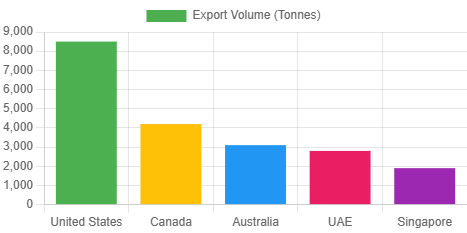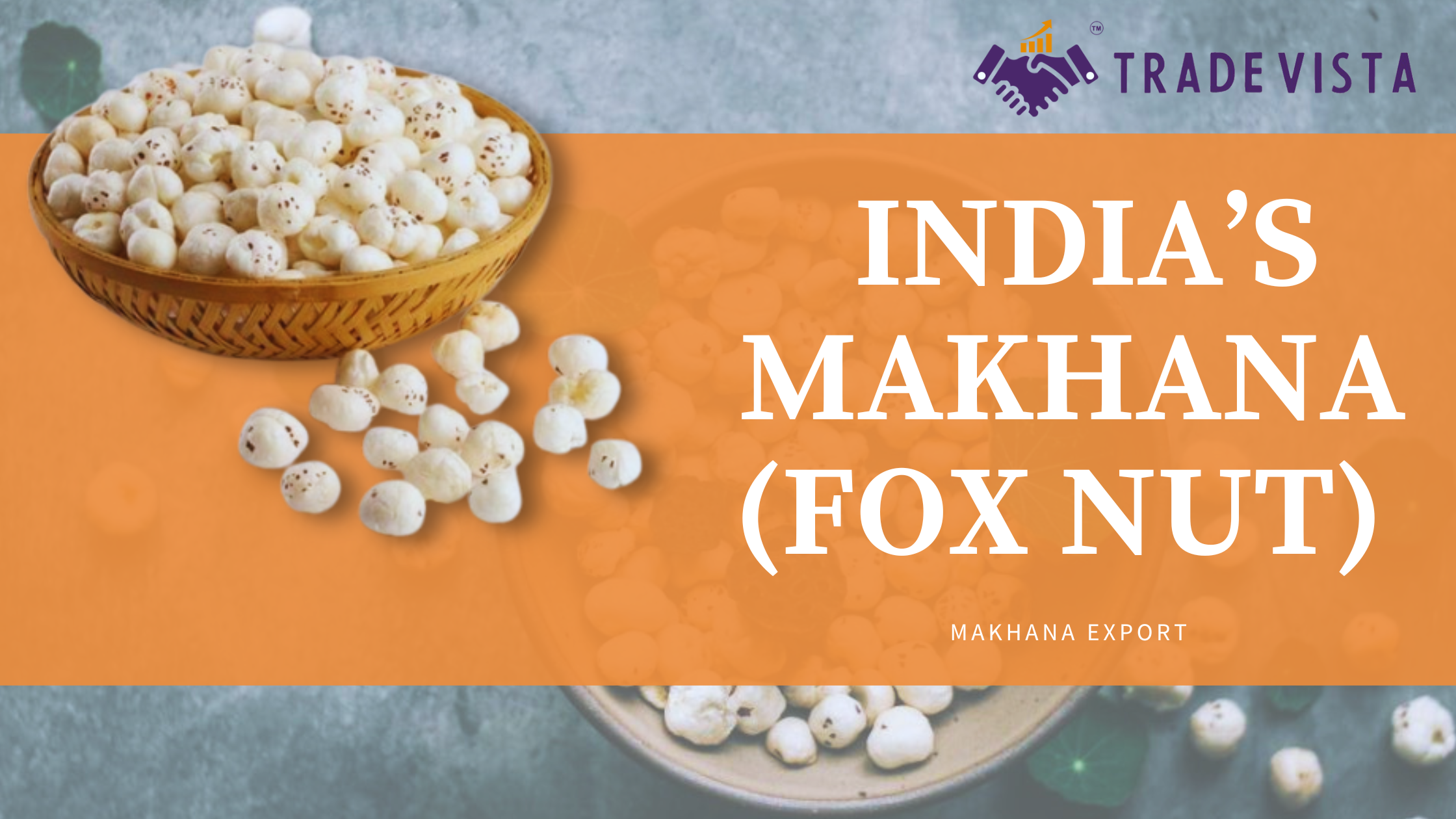Bihar accounts for over 80% of India’s Makhana (fox nut) production, with the Madhubani district being the epicentre due to its ideal aquatic ecosystem for cultivating Euryale ferox plants. The state’s “Mithila Makhana” received a Geographical Indication (GI) tag in 2022, enhancing its global recognition as a premium product.
Global Market Potential for Makhana
The global Makhana market is projected to grow from $128 million in 2024 to $187 million by 2031, at a 5.6% CAGR. Key demand drivers include rising health consciousness, vegan diet trends, and snacks, desserts, and Ayurvedic product applications.

Global Makhana Market Growth (2024-2031)
Top Importing Regions:
- North America (35% share)
- Europe (25% share)
- Asia-Pacific (20% share)
Projected Growth
- The global Makhana market is projected to grow at a CAGR of 8.1%–11.9%, reaching USD 265.4 million by 2035 and USD 97.5 billion by 2030.
- Asia Pacific dominates the market (81% share in 2023), driven by India’s 90% global production.
Emerging Markets
- Demand is rising in the U.S., Europe, and the Middle East, driven by health-conscious consumers and plant-based diets.
- The U.K. market is growing at a 7.5% CAGR, and Fox Nuts is positioned as a gluten-free, organic snack company.

Global Makhana Market Size (2023–2035)
Production and Export Readiness
- Key Production Regions
- Bihar accounts for 90% of global Makhana production, with Madhubani holding a GI tag.
- Government initiatives include subsidies for farmers and infrastructure development.
- Manufacturing Process
- Steps like popping, roasting, and grading ensure quality for exports.
- FSSAI, US FDA, and EU Organic certifications are mandatory for international compliance.
Government Schemes and Support for Makhana
- Makhana Board: Launched in 2025 to streamline production, processing, and export infrastructure in Bihar.
- Farmer Producer Organizations (FPOs): Over 50 FPOs established to empower small-scale farmers with collective bargaining and training.
- Export Incentives: Subsidies under the Agriculture Export Policy and reduced GST rates (5% for raw Makhana).
- GI Tag Protection: Boosts branding and anti-counterfeiting measures globally.
Challenges & Solutions for Makhana Export
Challenge | Solution |
Fragmented supply chain | FPO-led aggregation and cold storage subsidies |
Limited processing units | PPP models for modern processing facilities |
Competition from China | GI tag enforcement and quality certifications (e.g., USDA Organic, FSSAI) |
Key Challenges
High labour costs, storage complexities, and competition from alternative snacks.
Regulatory hurdles for organic certification and export logistics.
Innovative Strategies
Flavoured variants (e.g., peri-peri, chocolate) and value-added products like Makhana flour.
Leveraging e-commerce platforms for global reach.
Steps to Start a Fox nut Export Business
- Registration: Obtain IEC (Import Export Code) and GSTIN.
- Quality Compliance: Secure certifications like ISO 22000, HACCP, or Fair Trade.
- Supplier Partnerships: Connect with Bihar-based producers (see supplier tables below).
- Logistics: Partner with export-friendly ports like Mundra or Kolkata.
- Market Research: Target regions with high vegan/health food demand (e.g., North America, EU).
Suppliers from Alibaba.com
Company Name | Location | Main Products | Annual Revenue | Export Ports |
CHAVO VIRO POLYGON PRIVATE LTD | Bihar, IN | Masala Makhana, Spiced Foxnuts | Below $1 Million | Haldia |
SHRISHTI TRADERS | Bihar, IN | Raw/Roasted Makhana | $2.5M – $5M | Kolkata, Mundra |
ORGANIC SMILE | Uttar Pradesh, IN | Organic Makhana | Below $1 Million | Mundra, Nhava Sheva |
GENIEMAMA IMPEX PRIVATE LTD | Andhra Pradesh, IN | Export-Quality Foxnuts | $1M – $2.5M | Visakhapatnam |
More Suppliers (Global B2B Platforms)
Company Name | Location | Business Type | Key Markets |
Du Overseas | Bihar, IN | Exporter | North America, EU |
Global Gale | Gujarat, IN | Manufacturer | Asia-Pacific, Mid-East |
Vamika International | Gujarat, IN | Rice & Makhana Exporter | Africa, Southeast Asia |
Success Stories
- Madhubani Makhana: Leveraged GI tag to secure contracts with retailers like Whole Foods.
- Indian Foxnuts: Achieved $5M+ annual revenue by exporting flavoured Makhana to the EU and UAE.
FAQs on Makhana Export
1. What Are the Key Challenges Makhana Farmers face in Scaling Production?
Makhana cultivation remains labour-intensive, climate-dependent, and reliant on traditional methods. Farmers face hurdles such as manual harvesting, water-level fluctuations, and limited access to modern technology.
2. How Is Climate Change Impacting Makhana Yields in Bihar?
Makhana thrives in shallow water, making it vulnerable to erratic rainfall, droughts, and floods. Such climate shifts disrupt production cycles and reduce farmers’ profitability.
3. What Role Does the Makhana Board Play in Boosting Exports?
The Bihar government’s Makhana Board (established in 2025) aims to modernise farming, improve processing infrastructure, and streamline exports. It focuses on training farmers, promoting high-yield seeds, and enhancing market access.
4. How Can Exporters Navigate Quality Control and Certification Requirements?
International markets demand adherence to strict quality standards. Exporters must implement certifications (e.g., organic, FSSAI) to build credibility and ensure traceability.
5. What Are the Emerging Markets for Indian Makhana Beyond Traditional Buyers?
While the U.S., Canada, and the UAE dominate imports, new opportunities emerge in Africa, South America, and Russia. Exporters are exploring these regions through tailored marketing.
6. How Does the Supply Chain Structure Affect Makhana Profitability?
The fragmented supply chain involves multiple intermediaries, reducing farmers’ profit margins. Direct marketing and Farmer Producer Companies (FPCs) are proposed solutions to shorten the chain.
7. What Innovations Are Driving Value-Added Makhana Products?
Exporters diversify into flavoured snacks (e.g., peri peri, Thai chilli), makhana flour, and ready-to-eat bars to cater to global taste preferences.

8. Why Is the GI Tag for Mithila Makhana Not Fully Benefiting Farmers?
Despite the GI tag, only 67 authorised users are registered, mostly from non-core production districts like Kishanganj. Farmers in Darbhanga and Madhubani remain underrepresented, limiting their earnings.
9. How Can E-Commerce Platforms Accelerate Global Makhana Sales?
Online platforms like Amazon and niche health-food websites enable direct consumer access. Exporters leverage these channels to bypass traditional retail bottlenecks and tap into health-conscious demographics.
10. What Steps Are Needed to Ensure Sustainable Makhana Farming Practices?
Proposed measures include adopting high-yield seed varieties (e.g., Swarna Vaidehi), mechanised harvesting, and government-backed price guarantees to protect farmers from market volatility.
Table: Top Challenges and Solutions for Makhana Exporters
Challenge | Solution |
Price fluctuations | Flexible pricing strategies |
Trade policy complexity | Partnering with local distributors |
Labour shortages | Training programs for youth |




